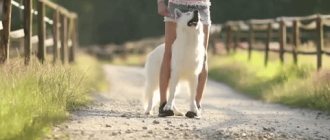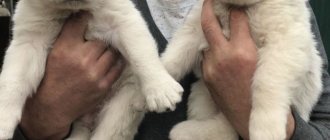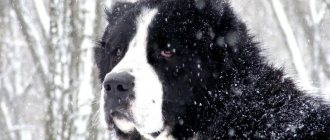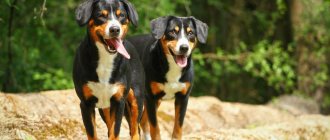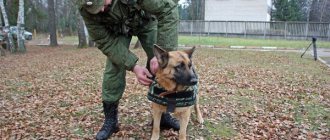| Origin: | Switzerland |
| Usage: | guard, herding dog, companion, guide |
| Color: | white |
| Dimensions: | weight of males - from 30 to 40 kg, females - from 25 to 35 kg; height at the withers, respectively, from 60 to 66 cm and from 55 to 61 cm. A deviation in height of 3 cm in any direction is allowed. |
| Lifespan: | 15 years |
The White Shepherd is a dog that is distinguished by excellent service qualities and extraordinary beauty. And in the family it is also a wonderful companion. The White Swiss Shepherd breed has not been known for long, as it was officially recognized in 2003, although it has been bred along with the German Shepherd since the end of the 19th century. This breed is also called for short BShO, American-Canadian White Shepherd.
How the breed appeared
The history of the breed is inextricably linked with the German Shepherd - they have common roots and are similar in appearance. In the 19th century, the Germans gained popularity, which spread beyond Europe. The breed became interested in the USA and Canada.
At the beginning of the 20th century, color was of little interest to breeders; the main attention was paid to working qualities. However, with the Nazis coming to power in Germany, the demands increased, as dogs went to serve in the army, but German shepherds did not meet them. The culprit was the gene responsible for the white coat color.
White animals were rejected. In America, this position was not shared, and they actively developed white dogs into a breed separate from German shepherds.
The resulting breed was called the American-Canadian White Shepherd. It was forbidden to cross it with the German one. It was with this name that the animals came back to Europe.
The first male was brought to Switzerland from America, and the female from England. They became the founders of the breed in Switzerland. Precisely because these animals were noted in the registered stud book of Switzerland, and not of another country. The FCI recognized the breed in 2003 with the name White Swiss Shepherd. Then the official breed standard was adopted.
Exterior and character
This powerful dog is similar in appearance to a simple German Shepherd.
Their height is almost the same, but the white pet is built a little denser and looks larger. Representatives of the breed with medium-length hair and long-haired individuals are known throughout the world.
Let's look at the exterior features of a shepherd dog:
- The body of this shepherd is elongated and slopes towards the tail;
- powerful back;
- strong chest;
- pronounced withers;
- strong, elongated, curved neck;
- lack of suspension;
- soft line of transition from forehead to muzzle;
- elongated muzzle, tapering towards the nose;
- not a large nose;
- nose color is black or dark;
- black lips;
- erect, high ears;
- small, slanted, dark-colored eyes;
- powerful and strong limbs;
- black oval paws;
- fluffy tail.
As for the coat, it is exclusively white, thick, mated, and has a good undercoat. The hairs are hard and straight. The hair is longer in the area of the neck and hind legs. There is a fluffy mane on the neck. There are individuals with a slightly wavy coat - this is quite acceptable, but it is not common.
The character of this white animal is reserved and gentle in disposition. This active, playful dog will not leave anyone indifferent. Despite her good disposition, she serves as a good protector for her owner, since she shows aggression in case of any threat to him. This breed is similar in character to its relative, the ordinary shepherd dog. It has the characteristics of a service dog, such as good reaction, endurance, and strength.
If you want to get yourself a pet or a pet and don’t know what breed, choose a white German Shepherd and over time you will be convinced that you have made the right choice. These dogs are very affectionate, playful, but attention-demanding creatures. Thanks to their easy-going nature, they get along well with all family members, including children and even pets, such as cats. But, at the same time, in a critical situation, shepherd dogs are ready to stand up for the owner and household members.
Description of the standard
The White Swiss Shepherd is a stately dog with a toned belly, well-developed body and graceful appearance. The curves of the body are smooth, and its length is greater than its height.
The standard describes the parameters that the breed must have:
- Head. Medium in size, the skull is wedge-shaped, but should not be elongated, as, for example, in a collie. A round and short muzzle is not acceptable. It should be dry and strong.
- Nose. The breed standard predetermines the color of the earlobe as black. Pigment deficiency is not acceptable. Other colors and shades may be disqualifying.
- Lips. Dark color. Should fit snugly to the jaw. White pigmentation is not acceptable.
- Teeth. BShO have strong teeth. Scissor bite. Snacking is a reason for disqualification.
- Eyes. Almond-shaped, medium in size, located at an angle. The color brown and its shades. The outline is black. Blue or pink color – disqualification.
- Ears. Triangular in shape, set high on the head, erect, oblong. Proportional to the size of the head. Soft ears are considered defective.
- Neck. Strong, muscular, rounded at the withers.
- Body. Muscular with pronounced withers. Straight line of the back, wide croup with a slope towards the tail. The chest is deep with a prominent sternum. The ideal ratio of body length to height is 10 to 8.8.
- Tail. Saber-shaped, fluffy. Thick at the base, tapering towards the end. Should not bend towards the back. The maximum is a right angle with respect to the ridge. A short, cropped tail is a serious fault.
- Legs. The front legs are widely spaced and straight. The shoulders are long, the elbows fit tightly to the body and are in line with the withers. Hind legs with pronounced hock joints. Feet should be pointing straight forward, legs parallel to each other.
The American-Canadian White Shepherd, according to the standard, moves with fast steps and, when accelerating, at a trot. Moves easily, gracefully, harmoniously.
The Swiss White Shepherd can have long or short hair. The coat is dense and dense. Shorthair - most popular in France and Germany. In areas with harsh climates, the long-haired BShO has become more widespread.
Pale cream or tan colors are acceptable but not preferred. Color is considered a secondary indicator when assessing the qualities of a breed. Character, movements and general qualities come first.
The history of the white dog or almost everything about the BShO breed
The development of cities is always associated with the development of crime on any continent and in any country. During the era of enlightenment and infrastructure development of the 18th century, the German principalities were literally covered with a wave of new crimes. It was then that the question arose about creating a service dog to help the police.
The BShO breed standard was adopted by the FCI only in 2002
Philax Society
A voluntary cynological community "Philax" appeared, which set itself the goal of obtaining service dogs from local shepherd dogs from different regions of Germany. The basis was based on small, nimble working “shepherd dogs” from Thuringia, Bavaria and Saxony, and they were paired with bony, broad-chested shepherd dogs from Württemberg, with long powerful legs, erect ears and a zone-gray wolf color.
“Philax” even managed to organize several exhibitions, where it presented a new, still raw breed under the general name “German Police Service Dogs” (Büropolizei Schäferhunde Deutschland):
- Hanover 1882 – gray and white males;
- Hanover 1887 – males and females of zone gray and white;
- Hamburger 1888 - overwhelmingly white dogs;
- Kassel 1889 – all the “Germans” represented are the same white color.
Torn by internal disputes about what the breed should ultimately become, the Philax community did not last long, but it managed to sow positive seeds:
- Drew society's attention to the value of many qualities inherent in herding dogs.
- Developed a certain view on the required type of service police dog.
- The talent of a great dog handler was discovered in the retired cavalry captain Max von Stefanitz, whose life resulted in the creation.
German Shepherd
After the dissolution of Philax, Max Stefanitz acquired his own kennel in Grafrath, where he and his friend Arthur Mauer continued to try to create the desired type of police dog.
On April 3, 1889, as usual, they visited a dog show in Carlorue, where they noticed a zonal yellow-gray male, the size of a wolf, standing at the feet of the dejected owner. The despondency of the dog's owner was explained by the fact that they were not allowed into the ring, because... The judges were unable to determine the breed, although the owner once paid a lot of money for the puppy.
But friends immediately determined that this dog was the result of mixed blood of dogs from Saxony and Württemberg, and, most likely, the puppy was purchased from the Philax society.
The first of the first - Horand
Both friends knew a lot about shepherd dogs, and this representative was a perfect representative of the desired breed - strong, springy, free in movement, harmonious, in the type of a primitive wolf dog.
The owner explained that the dog is a working dog, he is more than satisfied with the quality of its work and added that the dog differs from other herding dogs in its endurance, intelligence, independence and obedience. Plus, despite the external resemblance to a wolf, the dog tends to be in human company more often. The gray-yellow shepherd's name was Hector Lynx Rain.
After some arguing with the owner, Max and Arthur bought Hector and settled him in Stefanitz's kennel, giving him the name Horand von Grafrath.
A few days later, a new society SV was registered - Gesellschaft Zucht Deutsche Schäferhunde (German Shepherd Breeding Society), where the first number in the stud book of pedigrees was Horand von Grafrath; information about parents: “UNKNOWN” - unknown.
Horand von Grafrath
From the moment Horand was registered, the search began for females similar in quality to the male for breeding the desired type. It turned out that the most suitable type would be the Old German Shepherd Dog Kuchhunde or the Old German Shepherd Spitz-Tiger (the common name in Southern Germany for all herding dogs of the marbled white and black color “merle”).
Unknown danger
Back in 1889, no one had yet imagined that in the homozygous state the white merle color gene, which gives a solid white color, when compacted in the genome, carries such dangers as:
- various anomalies of eye development;
- deformities or non-viability of fetuses;
- partial or complete deafness;
- blue pigmentation of the iris and nose or light inclusions;
- oddness of eyes;
- high degree of sterility.
Fortunately, females of other colors were also involved in mating, bringing in new blood using standard inbreeding for several specimens with strict selection, both in terms of external characteristics and working qualities.
Horand as a producer
Soon, a fairly diverse population began to take shape, like a mosaic, in the direction of the desired type of appearance and behavior. The uniqueness lies in the fact that an excellent high-quality breed was bred from one male, possessing a perfect exterior appearance and excellent service qualities.
Judging by the history of origin, the “father of the breed” Horand von Grafrath himself was related to marbled and white herding shepherd dogs, so the transmission of the white gene to his descendants was inevitable. This is partly confirmed by the fact that many of his grandchildren, great-grandchildren and great-great-great-grandchildren have white markings on various parts of their bodies.
Horand sired many puppies, 140 of which were included in the Society's studbook, but his most outstanding son was Hector von Schwaben. Hector's sons Beowulf, Gates and Pilot became the founders of outstanding pedigree lines, where the white gene was present, which later played a very cruel joke on snow-white German shepherds.
By the beginning of the 20th century. The popularity of the German Shepherd, used not only in pastures, but also in the police and army, has increased so much that the fame of its endurance, obedience and intelligence has gone far beyond the borders of Germany.
Although the emphasis in breeding was primarily on working qualities, the white coat color still gave these dogs a special charm.
The snow-white, smart dogs quickly won the hearts and souls of private dog breeders, and many tailed police officers were sold to the countries of Great Britain, and from there brought to Canada and America.
BShO descended from old-type German Shepherds
Expulsion of the white dogs
Meanwhile, work on improving the German Shepherd in Germany continued. Color for a working dog was considered something of secondary importance; breeding work under the patronage of Max von Stephanitz was aimed at increasing the requirements for the breed and expanding its professional capabilities.
But in 1936, the greatest dog handler who closely monitored his brainchild - the German Shepherd - Max von Stefanitz died.
He had long ago realized that when 2 white shepherds are mated, only white puppies are born, but these offspring have too many health problems, and he made sure that the white shepherd was always paired with a normally colored male.
The descendants of such a pair carry the white gene in a latent state. The next mating between normally colored dogs in 90 cases out of 100 will definitely produce one or more white puppies in the litter, if at least one of the parents has a homozygous white gene. By crossing white offspring with normally colored individuals, we get all puppies of normal color. And such a cyclical breeding process should not be disrupted in order to preserve the health of the entire breed.
Left without a strict “look,” the newly minted breeders-improvers-amateurs-destroyers redoubled their efforts in obtaining the shepherd dogs that are in greatest demand - light-haired ones, violating all the rules of genetics.
The offspring they bred not only did not correspond to the title of “Perfection Itself,” but led to the degeneration of the breed as a whole.
When crossing two white shepherd dogs, the offspring were very often sick
Even during the life of Max von Stefanitz (1933), the All-German Cynological Society raised the issue of excluding dogs with the recessive white gene from further breeding, but then Stefanitz was able to defend them. After his death there was no one to do this.
Pragmatic Germans correctly associated degenerative tendencies with the presence of individuals with light or completely white hair. German breeders had no time to understand the intricacies of the “genealogical method of establishing the type of inheritance with the predicted probability of the appearance of certain characteristics of the future generation” (Mendel’s Laws of Heredity) - Germany was starting the World War.
Weak, prone to allergies, producing a large percentage of blind, deaf or non-viable puppies, white shepherd dogs of the “post-Stephanitz period” did not in any way meet the needs of the Wehrmacht army, and were mercilessly eliminated from breeding in Germany. Since that time, the paths of white and colored shepherds have completely diverged.
It must be said that the remaining individuals in the breeding still benefited from this split, acquiring the familiar external features and character of the black-and-red Old German Shepherd Dog today.
But distant interrupted kinship is a no-no and reminds of itself with “gray hair” on the muzzles and bodies of the BUT and small white “stars” on the chest.
Psychological picture
American-Canadian dogs have developed intelligence and are easy to train. The character is flexible. They are distinguished by their friendliness, cheerfulness, and patience.
The Swiss have a good memory. An intelligent dog subtly senses the mood of people, is easy to train, and can participate in all types of competitions.
Protective qualities are genetically inherent, so over time the pet begins to control the safety of family members and other pets. However, BShO are not defenders, to the same extent as the Germans. Over the years of selection, their character has softened. Therefore, they lose to the Germans in defense competitions.
Representatives of the breed have a wide vocal range and love to express their mood out loud. This way they also communicate with their family.
For sociable dogs, an important factor of comfort is communication with the owner.
Application
Character traits and temperament allow the Swiss Shepherd to be used in the work of rescue services and the police.
BShO is one of the most active service dogs.
The dog is highly sensitive, human-oriented, and clearly perceives commands. She subtly senses people's moods and reacts delicately. At home, he is a faithful companion and friend.
In medical institutions in Europe and America, the White Swiss Shepherd is used as rehabilitation therapists. They also develop the skills of guides. For blind people, BShO is a faithful assistant.
Personality of the White Swiss Shepherd
The White Swiss Shepherd is energetic and cheerful. However, she is more reserved than her German counterpart. The BShO is softer and more good-natured, but in case of a threat he will immediately show the strength, reaction and intelligence characteristic of the service breed.
In this regard, White Swiss Shepherds make good bodyguards, rescuers and guide dogs.
They love sports and travel, so they make excellent companions for energetic people.
In the family, White Swiss Shepherds are affectionate. They love their owners and get along well with other pets. These dogs are quite reserved with strangers, but not aggressive.
BShOs need company, so this breed is not suitable for busy people. The White Swiss Shepherd requires a lot of walking and playing. In addition, she does not mind “talking” to the owners, demonstrating her unique vocal abilities.
This is interesting! The vocal cords of White Swiss Shepherds are truly amazing. Thanks to them, these dogs make a wide range of sounds: from howling to grunting. The tonality is also varied: BShO are capable of guttural whining and high-pitched squealing.
White Swiss Shepherd and children
This breed is perfect for families with small children. The White Swiss Shepherd is quite patient and lenient towards the mischief of the little inhabitants of the house.
Moreover, BShO literally herd and protect children and small animals.
How to choose a puppy
You should buy a puppy through a kennel club or from reputable breeders. When purchasing, in order to avoid troubles and not be deceived, you need to:
- Ask about the documents of the puppy and parents. To confirm the pedigree, this is a necessary condition.
- Don't rush to choose a pet. It is important to observe his behavior for some time. White Shepherds show mobility from an early age. Hyperactivity and aggressiveness are weaknesses.
- Check to see if the breeder has an X-ray of the puppy’s spine and a BEAR test to confirm the absence of congenital deafness.
- Learn about the inbreeding test. If there have been inbreedings in the family, the puppy may exhibit character traits that are not typical for this breed.
In the photo you can see that the white Swiss Shepherd puppies are without tan marks or additional shades. This also needs to be taken into account when choosing.
Since the babies do not have distinctive features confirming the purity of the breed, documents are required.
Training
The animal's intelligence and distinctive intelligence allow them to quickly learn and remember various commands. To raise a socially developed puppy, it is necessary to introduce it to people and other animals as often as possible.
Education should be gentle, without shouting and aggression; under no circumstances should a white shepherd be punished, since it will not tolerate disrespectful treatment of itself. It is better to reward your pet with special treats; this will be much more effective than reproaches and aggression. The Swiss are active, so it is necessary to conduct training in the fresh air; the form of the game is perfect.
Grooming and maintenance
Despite the aristocratic appearance and gentle character inherent in nature and the efforts of breeders, the white shepherd requires training and discipline. The description of the breed says that it is highly intelligent, so upbringing should be strict, but not harsh. Rudeness and harshness are equally intolerable to adult dogs and white Swiss shepherd puppies.
For maintenance, the conditions of a private house with a large territory are preferable. To maintain good physical shape, pets require regular exercise and training.
The dog is able to remember a large number of commands. Therefore, in addition to high physical activity, exercise is needed to develop mental abilities.
Care and illness
The main component of care is sufficient physical activity. A Swiss Shepherd should be outside at least three to four times a day and have constant physical activity: running, jumping. Intellectual load will also not be superfluous, for example, games with a ball and Frisbee will help your pet keep himself in good shape. A dog can run behind a bicycle or just next to its owner while jogging. After walks in the spring and autumn, it is advisable to inspect the luxurious wool for tick infestation. Periodically you need to treat your dog for helminths.
The next important point is wool. Thick and lush fur is prone to loss due to constant shedding, but seasonal shedding is unpleasant and abundant. In order to reduce its extent in the house, you need to brush your dog daily for ten to fifteen minutes. Swimming is recommended when soiled. The White Swiss Shepherd is not afraid of water and takes the procedure calmly. Before exhibitions and competitions, it is recommended to visit a groomer who can bring the pet’s coat to ideal condition.
Like other dog breeds, the Swiss White Shepherd needs ear and eye care. They are inspected at least once a week, wiping them with a clean rag as necessary. The claws wear down from active play, but if this does not happen, they are trimmed as necessary. You need to brush your teeth often, as shepherds quickly develop plaque that turns into tartar. To do this, you need to purchase a toothbrush and toothpaste in a specialized store.
The average lifespan of a shepherd is fifteen years. The main diseases of BSH:
- Yellowing of fur. This problem occurs in dogs that do not receive adequate nutrition and is treated with vitamins.
- Food allergies. Shepherds are frequent allergy sufferers, so you should monitor your pet’s reaction to any new product.
- Diseases of the musculoskeletal system. Many dogs have congenital diseases, so it is advisable to pay attention to the pedigree when choosing a puppy. But a dog can get sick even during adulthood. Reasons: sedentary lifestyle and lack of nutrients.
- Deafness. The color of a dog's coat is not a sign of albinism; the dog must have dark skin and eyes. If a white dog is an albino or has blue eyes, most likely, its hearing will disappear over time, since this relationship is genetically determined.
Walk
In order for BShO to remain cheerful and healthy, she needs to be walked. When kept in a country house with a large local area, the issue of walking is resolved by itself. But even in this case, it is necessary to train the pet, loading not only the muscular system, but also the intellect.
When kept in an apartment, many hours of daily walking are required. The dog must move a lot, run over rough terrain, and overcome obstacles.
If you don't provide your pet with enough exercise, it will lose its physical shape and may get sick.
Feeding
For a dog to be healthy, its diet must be complete and balanced. You can feed them natural food or premium dry food.
Puppies are given food 6 times a day, gradually reducing to 3 meals by the age of six months. An adult dog should be fed twice a day on a schedule.
The diet should contain:
- Daily – at least 0.5 kg of beef or other lean meat.
- Weekly – 2 – 3 eggs, raw or boiled.
- Dairy products.
- Porridge made from oatmeal, buckwheat and rice.
- Vegetables and fruits that BShO eats with pleasure: tomatoes, zucchini, apricots, berries.
You need to feed your dog on a schedule, teaching him discipline. After feeding, the bowls are removed. Drinking clean water should always be available.
It should be borne in mind that in winter the need for nutrients increases.
Diseases
Despite their good natural characteristics, the Swiss, like other breeds, have vulnerabilities:
- Deafness from birth.
- Hip dysplasia with age.
- Heart defects.
- Mental disorders (hyperactivity, aggressiveness, fearfulness and phlegmaticity).
- Allergies.
Conscientious breeders always provide complete information about the breed.
Vaccinations
To avoid dangerous viral and infectious diseases, it is necessary to get vaccinated on time:
- First, at 1.5 months, puppies are vaccinated against parvovirus and coronavirus enteritis, and against hepatitis.
- Revaccination after 2 weeks.
- The second - at 2.5 months. Puppies are vaccinated against distemper. Repeatedly – 6-7 months after changing teeth.
- The third - at 8 months from rabies.
Two weeks before vaccination, the puppy should be given anthelmintic drugs. At the time of vaccination, the pet must be healthy.
Health BShO
In most cases, BShO has no health problems. They are long-lived, often living up to 15 years or longer. Occasionally, articular dysplasia may occur and is common in large breed dogs. To avoid this disease, a puppy under the age of one year should be spared from heavy physical activity. And do not give puppies growth promoting medications. You can rid your puppy of a lot of canine infectious diseases by vaccination. Even if it does not completely get rid of possible infection, then vaccination can certainly reduce the likelihood of complications after an illness.
Photo: BShO Nutrition
Mating
Females reach sexual maturity by one year. However, early mating can have a negative impact on health, since the body is not yet strong enough and mature enough for pregnancy and childbirth. The optimal age for mating is 2 years.
Mating is carried out on the territory of the male. But first you need to introduce the dogs on neutral territory, for example, while walking together on the playground.
It is advisable to consult experienced dog handlers or breeders on how to choose the right partner for a BShO.
How much do puppies cost?
A purebred White Swiss Shepherd puppy is expensive. From breeders, the price can reach 50,000 rubles. All documents confirming the pedigree and giving the right to take part in exhibitions are provided for the animal.
Puppies without a pedigree are cheaper, but may carry admixtures of other breeds and therefore are not considered full-fledged BShO.
In Russia, several nurseries are engaged in breeding white shepherd dogs:
- Karnelix (Moscow).
- Beauty of Rus' (Moscow).
- Asgard (Yaroslavl).
- AusOttohof (Moscow).
White Shepherds are beautiful, friendly dogs. However, before getting this breed, you should carefully weigh everything. A dog requires a lot of attention and care.


